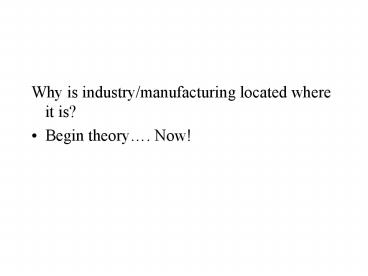Why is industry/manufacturing located where it is? - PowerPoint PPT Presentation
1 / 18
Title:
Why is industry/manufacturing located where it is?
Description:
Why is industry/manufacturing located where it is? Begin theory . Now! Location Theory Location Theory predicting where a business will or should be located. – PowerPoint PPT presentation
Number of Views:43
Avg rating:3.0/5.0
Title: Why is industry/manufacturing located where it is?
1
- Why is industry/manufacturing located where it
is? - Begin theory. Now!
2
The Paris Basin is the Industrial base of France.
Rouen (above) is at the head of navigation point
on the Seine River.
3
Location Theory
- Location Theory predicting where a business
will or should be located. - Location of an industry is dependent on economic,
political, cultural features as well as whim. - Location Theory Considers
- Variable costs-energy, transportation costs
labor costs - Friction of distance-increasing distance
increased time cost
4
Location Models
- Webers Model-The Least Cost Theory
- Alfred Weber, (1868-1958) a German economists,
published Theory of the Location of Industries in
1909. His theory was the industrial equivalent of
the Von Thunen Model. - Manufacturing plants will locate where costs are
the least. - Categories of Costs
- Transportation-the most important cost-usually
the best site is where cost to transport raw
material and finished product is the lowest - Labor-high labor costs reduce profit-location
where there is a supply of cheap, non-union labor
may offset transportation costs - Agglomeration-when a group of industries cluster
for mutual benefit-shared services, facilities,
etc.-costs can be lower - Deglomeration-when excessive agglomeration
offsets advantage-eastern crowded cities
5
Booming Town
Bunny Fur
Bricks
Webers Least Cost Theory Brick Bunny
Bulk Gaining Vs. Bulk Reducing.
6
Location Models
- Hotellings Model-Harold Hotelling (1895-1973)
this economist modified Webers theory by saying
the location of an industry cannot be understood
with out reference to other similar
industries-called Locational Interdependence - Loschs Model-August Losch said that
manufacturing plants choose locations where they
can maximize profit. Theory Zone of
Profitability
7
- How has Industrial Production Changed?
8
How has Industrial Production Changed?
- Fordist dominant mode of mass production during
the twentieth century, production of consumer
goods at a single site. - Post-Fordist current mode of production with a
more flexible set of production practices in
which goods are not mass produced. Production is
accelerated and dispersed around the globe by
multinational companies that shift production,
outsourcing it around the world.
9
Time-Space Compression
- Just-in-time delivery
- rather than keeping a large inventory of
components or products, companies keep just what
they need for short-term production and new parts
are shipped quickly when needed. - Global division of labor
- corporations can draw from labor around the
globe for different components of production.
10
Modern Production
Outsourcing moving individual steps in the
production process (of a good or a service) to a
supplier, who focuses their production and offers
a cost savings.
Offshore Outsourced work that is located
outside of the country.
11
Nike (A Light Industry)-Headquartered in
Beaverton, Oregon, Nike has never produced a shoe
in Oregon. Beginning in the 1960s, Nike
contracted with an Asian firm to produce its
shoes.
Skopje, Macedonia-The swoosh is ubiquitous, but
where is the shoe produced? Nike has a global
network of international manufacturing and
sales.
12
Maquiladora in Nuevo Laredo, Mexico repairs
telephones for ATT
13
New Influences on the Geography of Manufacturing
- Transportation-intermodal connections where air,
rail, truck, ship and barge connect-eases flow of
goods-e.g. container shipping Break of Bulk - Regional and global trade agreements-WTO,
Benelux, European Union, NAFTA, MERCOSUR, SAFTA,
CARICOM, ANDEAN AFTA, COMESA, etc. goal to ease
flow of goods by eliminating trade tariffs or
quotas - Energy-coal was replaced by natural gas oil
after WW II-transported by pipeline or tanker
14
- Europe-despite North Sea Oil-still must import
- Mexico Canada oil and natural gas
- U.S. uses 27 if oil 37 of natural gas
produced in the world. Dependent on imported oil - OPEC Saudi Arabia, Kuwait, Iraq, Russia large
oil reserves
15
- Deindustrialization
- a process by which companies move industrial
jobs to other regions with cheaper labor, leaving
the newly deindustrialized region to switch to a
service economy and work through a period of high
unemployment.
Abandoned street in Liverpool, England, where the
population has decreased by one-third since
deindustrialization
16
The Rust BeltvsThe Sun Belt
Flow of population.
17
(No Transcript)
18
THE END































